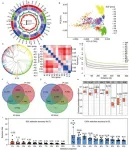Scientists have long been stymied by why some vaccines can coax the body to produce antibodies for decades, while others last mere months. Now, a study led by researchers at Stanford Medicine has shown that variation in vaccine durability can, in part, be pinned on a surprising type of blood cell called megakaryocytes, typically implicated in blood clotting.
“The question of why some vaccines induce durable immunity while others do not has been one of the great mysteries in vaccine science,” said Bali Pulendran, PhD, a professor of microbiology and immunology. “Our study defines a molecular signature in the blood, induced within a few days of vaccination, that predicts the durability of vaccine responses and provides insights into the fundamental mechanisms underlying vaccine durability.”
In a 2022 study, Pulendran and colleagues defined a “universal signature” that could predict an early antibody response to many vaccines. However, this and other studies did not define a signature that could predict how long antibody responses would last.
The new paper will be published Jan. 2, 2025, in Nature Immunology. Pulendran is the senior author, and formal postdoctoral scholars Mario Cortese, PhD, now at Gilead Sciences, and Thomas Hagan, PhD, now an assistant professor at the University of Cincinnati College of Medicine, are joint first authors. Nadine Rouphael, MD, professor of vaccinology and infectious diseases at Emory University, is a key contributor.
Driven to understand durability
Pulendran’s team initially studied an experimental H5N1 bird flu vaccine given with an adjuvant — a chemical mixture that enhances the immune response to an antigen but, on its own, does not induce an immune response.
The researchers followed 50 healthy volunteers who received either two doses of the bird flu vaccine with the adjuvant or two doses without the adjuvant. They collected blood samples from each volunteer at a dozen time points over the first 100 days after vaccination and carried out in-depth analyses of the genes, proteins and antibodies in each sample. Then, they used a machine-learning program to evaluate — and find patterns within — the resulting dataset.
The program identified a molecular signature in the blood in the days following vaccination that was associated with the strength of a person’s antibody response months later. The signature was mostly reflected in tiny bits of RNA within platelets — small cells that form clots in the blood.
Platelets are derived from megakaryocytes, cells found in the bone marrow. Platelets, when they break off megakaryocytes and enter the bloodstream, often take small pieces of RNA from the megakaryocytes with them. While researchers can’t easily track the activity of megakaryocytes, platelets carrying RNA from megakaryocytes act as proxies.
“What we learned was that the platelets are a bellwether for what is happening with megakaryocytes in the bone marrow,” Pulendran said.
Broader implications
To confirm whether megakaryocytes were affecting vaccine durability, Puledran’s research group simultaneously gave mice the bird flu vaccine and thrombopoetin, a drug that boosts the number of activated megakaryocytes in the bone marrow. Indeed, thrombopoetin led to a sixfold increase in levels of anti-bird flu antibodies two months later.
Further experiments showed that activated megakaryocytes produce key molecules that increase the survival of the bone marrow cells responsible for making antibodies, or plasma cells. When these molecules were blocked, plasma cells survived less in the presence of megakaryocytes.
“Our hypothesis is that megakaryocytes are providing this nurturing, pro-survival environment in the bone marrow for plasma cells,” Pulendran said.
The scientists tested whether the trend held true for other vaccine types. They looked at previously collected data on the responses of 244 people to seven different vaccines, including vaccines against seasonal influenza, yellow fever, malaria and COVID-19. The same platelet RNA molecules — signs of megakaryocyte activation — were associated with longer-lasting antibody production for the various vaccines. The molecular signature could predict which vaccines lasted longer, as well as which vaccine recipients would have a longer-lasting response.
Toward predictive and personalized vaccines
Pulendran and his colleagues plan to conduct studies that probe why some vaccines might spur higher levels of megakaryocyte activation in the first place. Those findings could help researchers develop vaccines that more effectively activate megakaryocytes and lead to more durable antibody responses.
In the meantime, the scientists want to develop tests to determine, using their newly discovered molecular signature, how long a vaccine is likely to last. That could help speed up vaccine clinical trials — in which researchers often must follow people for months or years to determine durability — but also could yield personalized vaccine plans.
“We could develop a simple PCR assay — a vaccine chip — that measures gene expression levels in the blood just a few days after someone is vaccinated,” Pulendran explained. “This could help us identify who may need a booster and when.” He added that the length of time a vaccine response lasts is likely affected by a number of complex factors, and he suspects that megakaryocytes are just one piece of the larger story.
Scientists from the University of Cincinnati; Emory Vaccine Center; University of California, San Diego; GSK Belgium; Hospital Israelita Albert Einstein; Jackson Laboratory; the Food and Drug Administration; Icahn School of Medicine at Mount Sinai; Emory University School of Medicine; the National Institutes of Health; and NYU Grossman School of Medicine contributed to the research.
Funding for this research was provided by the National Institutes of Health (grants R01 AI048638, U19 AI057266 and U19 AI167903), DARPA, the Bill and Melinda Gates Foundation, Open Philanthropy, the Violetta L. Horton and Soffer Endowments, and GlaxoSmithKline Biologicals SA.
Pulendran serves or has served on the external immunology board of GSK and on the scientific advisory boards of Sanofi, Medicago Inc., Boehringer Ingelheim, PharmaJet Inc., Icosavax Inc. and Ed-Jen.
# # #
About Stanford Medicine
Stanford Medicine is an integrated academic health system comprising the Stanford School of Medicine and adult and pediatric health care delivery systems. Together, they harness the full potential of biomedicine through collaborative research, education and clinical care for patients. For more information, please visit med.stanford.edu.
END






